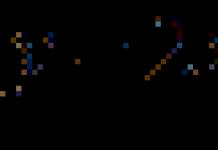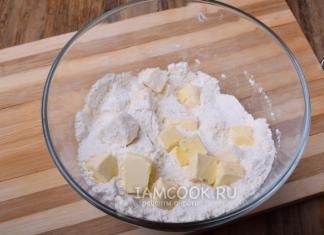“Bionics” is a word that has Greek roots and means “living.” This science studies different methods wildlife organizations in the field of industry.
Bionics in construction
First attempts to use natural forms The construction was undertaken by the Spanish architect Antonio Gaudi in the 19th century. Customer Eusebio Güell had long dreamed of “a practical, healthy home with beautiful shapes" Gaudi coped with the task masterfully. He squeezed into a narrow space (18 by 22 meters) a mansion reminiscent of both a mosque and a Venetian palazzo with a spacious ground floor, carriage house and stables. Behind the gray marble facade of the Güell Palace - luxurious interiors. No expense was spared on finishing: ebony, rosewood, tortoiseshell, ivory, one room is lined with eucalyptus, the other with beech, carved ceilings with applied leaves of gold and silver. It was here that Gaudí first made roofs with chimneys and ventilation pipes to the "garden of standing stones". Each turret is dressed in its own ceramic outfit.

 Guell and Gaudi also dreamed of turning Bald Mountain into a garden. And it was a breakthrough! Park Güell, or, as they used to say, “nature frozen in stone,” still has no analogues. Private villas would be surrounded by greenery, around the estates there would be paths, alleys, gazebos, fountains, grottoes, aqueducts, plus security around the perimeter. The project failed commercially. Only two plots out of sixty were sold; wealthy people did not want to live so far from the city. Current Barcelona residents approve of the choice of location. The layout of the park resembles a compressed spring - winding paths rise from the foot to the top like serpentines and steep stairs. Now Park Güell is not only a joy for the soul and eyes, but also a great pleasure for Barcelona residents and tourists, because there are palm groves and fresh air. The park was above the smog level. And those who make it to the top are rewarded with a magnificent view of Barcelona and the sea.
Guell and Gaudi also dreamed of turning Bald Mountain into a garden. And it was a breakthrough! Park Güell, or, as they used to say, “nature frozen in stone,” still has no analogues. Private villas would be surrounded by greenery, around the estates there would be paths, alleys, gazebos, fountains, grottoes, aqueducts, plus security around the perimeter. The project failed commercially. Only two plots out of sixty were sold; wealthy people did not want to live so far from the city. Current Barcelona residents approve of the choice of location. The layout of the park resembles a compressed spring - winding paths rise from the foot to the top like serpentines and steep stairs. Now Park Güell is not only a joy for the soul and eyes, but also a great pleasure for Barcelona residents and tourists, because there are palm groves and fresh air. The park was above the smog level. And those who make it to the top are rewarded with a magnificent view of Barcelona and the sea.
Mansion "Nautilus"
As their creative manifesto, Mexican architect Javier Senosian and his colleagues from the bureau built a house in the town of Naucalpan (Mexico City). Critics immediately declared the construction an allusion to the crazy “vegetative” structures of Antoni Gaudi. Indeed, something in common can be found in architectonics and decor. Although the prototype of the dwelling was not a plant or a flower, but the twisted shell of a nautilus mollusk.


“I’ve always been interested in feeling what it’s like to live in a shell,” the architect laughs. The interior of the house is dynamic thanks to spiral staircases, curved volumes and mother-of-pearl finishes (mosaic). Daylight, penetrating through the main stained glass window and round skylights in the roof, creates a mysterious atmosphere. Main building material reinforced cement has become incredibly plastic. In addition to this, the architects used Grancrete granite ceramics, mosaic tiles, glass and a natural stone.


Bionics in the interior
Bionics appeared and began to actively develop in Europe in the twenties of the twentieth century, but it reached its full flowering only in the seventies, acquiring its current appearance and being recognized as an independent style.
 The pace of life modern society, huge distances and intense human activity lead to the fact that city residents have practically no free time for their personal lives. But for busy, mobile and business people The comfort and coziness of personal space is very important. Often home becomes the only place where a person can fully rest, relax and isolate himself from the hustle and bustle. big city. Bionic architecture is addressed to man, to his inner world, because the interior should have a positive effect on a person’s well-being, mood and reveal his creative abilities.
The pace of life modern society, huge distances and intense human activity lead to the fact that city residents have practically no free time for their personal lives. But for busy, mobile and business people The comfort and coziness of personal space is very important. Often home becomes the only place where a person can fully rest, relax and isolate himself from the hustle and bustle. big city. Bionic architecture is addressed to man, to his inner world, because the interior should have a positive effect on a person’s well-being, mood and reveal his creative abilities.
 The interior of the biodome is a continuation of the house itself. This style tries to avoid right angles and straight lines. The characteristic elements of this style are the smoothness of lines and the massiveness of furnishings. Textures and decorative elements interiors are repeated with the same harmony and the same grace that we are accustomed to seeing in living nature. A clear demarcation and zoning of space will be inappropriate here, as well as a clear transition between surfaces. Forms in interiors, as a rule, are borrowed from the living environment and recreated with modern technologies.
The interior of the biodome is a continuation of the house itself. This style tries to avoid right angles and straight lines. The characteristic elements of this style are the smoothness of lines and the massiveness of furnishings. Textures and decorative elements interiors are repeated with the same harmony and the same grace that we are accustomed to seeing in living nature. A clear demarcation and zoning of space will be inappropriate here, as well as a clear transition between surfaces. Forms in interiors, as a rule, are borrowed from the living environment and recreated with modern technologies.
 Traditional for this direction is the use light color range, glossy and even mirror textures, as well as patterns characteristic of nature. Can be used in furnishings perforation in order to reduce the weight of the structure. Bionic colors: white, milky, ivory, beige, very light gray, greenery, sky, water, bark, sand and others. Possible elements bright colors: blue, scarlet, lemon. Everything is like in nature!
Traditional for this direction is the use light color range, glossy and even mirror textures, as well as patterns characteristic of nature. Can be used in furnishings perforation in order to reduce the weight of the structure. Bionic colors: white, milky, ivory, beige, very light gray, greenery, sky, water, bark, sand and others. Possible elements bright colors: blue, scarlet, lemon. Everything is like in nature!
Elements of biointerior

Agree, it’s interesting to be among flowers or funny objects, maybe reminiscent of something specific, or maybe completely unlike anything and awakening your imagination? In bionic forms, natural stylizations can be applied to both subject environment the interior as a whole, and to individual design items.
 For example, bionic lamps are geometrically out of line correct forms. So, if you take any classic chandelier in modern or classic style - with crystal pendants, forged elements - a quick glance is enough to see the geometry in its base. And in bionics more often–
unusual shapes, illogical lines. However, often chandeliers of classical styles can contain elements of bionics:yeah, it's a pretty popular idea decorations ceiling lamps decorative fruits made of Murano glass.
For example, bionic lamps are geometrically out of line correct forms. So, if you take any classic chandelier in modern or classic style - with crystal pendants, forged elements - a quick glance is enough to see the geometry in its base. And in bionics more often–
unusual shapes, illogical lines. However, often chandeliers of classical styles can contain elements of bionics:yeah, it's a pretty popular idea decorations ceiling lamps decorative fruits made of Murano glass.
Bionic lamps can be divided into two groups: classical and avant-garde.

The classic line in interior bionics is formed by lamps made of traditional materials: bronze, crystal, rhinestones, reproducing in detail flowers and withblossoms and bouquets exotic plants, maple or oak carved leaves. Any plant motifs : leaves, herbs, flowers, fruits - here the imagination of artists is inexhaustible, asthe world of flora is inexhaustible.
 However, the bionic style includes not only images of flowers and fruits. The vanguard line consists of associations inspired by nature, embodied by the designer in a static interior, furniture objects, structures, opening designs, etc. For example, jellyfish or stones frozen in the corner are actually lamps that provide soft and scattering light; in the corner there is a chair that resembles a bee or a flower petal, and in the center of the room there is a sofa that looks like a cloud. In bionic interiors, this “quotation” is often found natural elements and their forms.
However, the bionic style includes not only images of flowers and fruits. The vanguard line consists of associations inspired by nature, embodied by the designer in a static interior, furniture objects, structures, opening designs, etc. For example, jellyfish or stones frozen in the corner are actually lamps that provide soft and scattering light; in the corner there is a chair that resembles a bee or a flower petal, and in the center of the room there is a sofa that looks like a cloud. In bionic interiors, this “quotation” is often found natural elements and their forms.
Jean-Marie Massot. All the best comes from nature
 One of the most prolific architects and designers who became famous in the 2000s, Jean-Marie Massaud, follows the ideas of bionics and technofuturism in his projects. He encourages looking to nature for ideas for interior design and architecture. Let's consider what pieces of furniture should be in order to comply with these principles.
One of the most prolific architects and designers who became famous in the 2000s, Jean-Marie Massaud, follows the ideas of bionics and technofuturism in his projects. He encourages looking to nature for ideas for interior design and architecture. Let's consider what pieces of furniture should be in order to comply with these principles.
 1. Consist of high-tech materials. Interior bionics often uses high-tech materials and organic synthesis products. Jean-Marie Massaud believed that polymers go well with traditional natural materials, complementing them and creating a fundamentally new organic space. Artificially synthesized and processed materials provide completely new level comfort, withstand high loads and are extremely easy to maintain. Materials of the “future” are resistant to contamination, are lightweight, and, depending on their purpose, can for a long time keep warm or, on the contrary, not heat up.
1. Consist of high-tech materials. Interior bionics often uses high-tech materials and organic synthesis products. Jean-Marie Massaud believed that polymers go well with traditional natural materials, complementing them and creating a fundamentally new organic space. Artificially synthesized and processed materials provide completely new level comfort, withstand high loads and are extremely easy to maintain. Materials of the “future” are resistant to contamination, are lightweight, and, depending on their purpose, can for a long time keep warm or, on the contrary, not heat up.
 2. Fits into the surrounding space.In bionics, an architectural building or garden me belle necessarily harmonize with the landscape. For example, bionics offers a house that is built into the slope of a hill and smoothly continues it, or a hotel floating in the air in the form of a cloud, or–If we're talking about about garden furniture–a chair with a frame made of fine mesh, reminiscent of a delicate haze with soft outlines.
2. Fits into the surrounding space.In bionics, an architectural building or garden me belle necessarily harmonize with the landscape. For example, bionics offers a house that is built into the slope of a hill and smoothly continues it, or a hotel floating in the air in the form of a cloud, or–If we're talking about about garden furniture–a chair with a frame made of fine mesh, reminiscent of a delicate haze with soft outlines.
 3. Mimic and dissolve in the landscape or interior.Intrusive accents are not characteristic of living nature, therefore the bionics in the interior are not replete with an excess of colors and volumes, allowing the space to always remain airy and light. A sofa on a thin frame, a screen made of smoky glass, a faucet made of shiny steel, as if merging with a stream of water, indicate their presence, but do not impose it.
3. Mimic and dissolve in the landscape or interior.Intrusive accents are not characteristic of living nature, therefore the bionics in the interior are not replete with an excess of colors and volumes, allowing the space to always remain airy and light. A sofa on a thin frame, a screen made of smoky glass, a faucet made of shiny steel, as if merging with a stream of water, indicate their presence, but do not impose it.
 4. Have natural forms.The silhouettes of buildings and objects can be streamlined and smooth, like shells or living organisms, less often–strict, like crystals, but always harmonious. Curvilinear objects often tend to the shape of a drop of water, starfish, flower, orthogonal- to the prism.
4. Have natural forms.The silhouettes of buildings and objects can be streamlined and smooth, like shells or living organisms, less often–strict, like crystals, but always harmonious. Curvilinear objects often tend to the shape of a drop of water, starfish, flower, orthogonal- to the prism.
 5. Give tactile pleasures.It’s unthinkable without them Live nature, and therefore bionics in the interior appreciates small streamlined objects that seem to fit into the hand, rounded shapes of plastic products that follow the curves of the body, armchairs and sofas consisting entirely of soft surfaces.
5. Give tactile pleasures.It’s unthinkable without them Live nature, and therefore bionics in the interior appreciates small streamlined objects that seem to fit into the hand, rounded shapes of plastic products that follow the curves of the body, armchairs and sofas consisting entirely of soft surfaces.
 6. Be concise. Simple forms and clearly readable silhouettes are dictated by expediency, convenience and ergonomics, be it the silhouette of a building or a paper holder that looks like a tree knot, the outline of a sofa that resembles the outline of a hill or wave, or a bathtub in the form of a sink flap.
6. Be concise. Simple forms and clearly readable silhouettes are dictated by expediency, convenience and ergonomics, be it the silhouette of a building or a paper holder that looks like a tree knot, the outline of a sofa that resembles the outline of a hill or wave, or a bathtub in the form of a sink flap.
 7. Show natural structure.Not only the external form, but also the “content” associated with it reminds of the connection with nature. The spherical building inside will appear as a series of caves-holes in soft rock, a glass prismatic table will demonstrate the cellularity of the internal compartments, the surface of a thermoplastic chair will reveal the porous structure of the material.
7. Show natural structure.Not only the external form, but also the “content” associated with it reminds of the connection with nature. The spherical building inside will appear as a series of caves-holes in soft rock, a glass prismatic table will demonstrate the cellularity of the internal compartments, the surface of a thermoplastic chair will reveal the porous structure of the material.
 8. Be able to build according to a modular principle.The principle of a honeycomb and crystals precisely fitted to each other suggests ideas such as sectional buildings, modular furniture, which is convenient to combine and line up horizontally or vertically.
8. Be able to build according to a modular principle.The principle of a honeycomb and crystals precisely fitted to each other suggests ideas such as sectional buildings, modular furniture, which is convenient to combine and line up horizontally or vertically.
 9. Please the eye with natural colors.Bionics in the interior welcomes shades of snow and soil, greenery, water and sky; they are the most popular in bionics. As in natural conditions, splashes of bright red or dazzling blue are delegated to single “accent” items with subtle silhouettes.
9. Please the eye with natural colors.Bionics in the interior welcomes shades of snow and soil, greenery, water and sky; they are the most popular in bionics. As in natural conditions, splashes of bright red or dazzling blue are delegated to single “accent” items with subtle silhouettes.
 10. Arouse a sense of humor.Without it, the smartest design becomes coldly pragmatic. Without a bit of self-irony, you can’t “invent” a sofa that looks like a sponge and a bathtub, or a sculpture the size of a greenhouse tree in which you can plant plants.
10. Arouse a sense of humor.Without it, the smartest design becomes coldly pragmatic. Without a bit of self-irony, you can’t “invent” a sofa that looks like a sponge and a bathtub, or a sculpture the size of a greenhouse tree in which you can plant plants.
"Construction Rules", No. 45 /2, July 2014
The copyright holder of all materials on the site is Construction Rules LLC. Full or partial reprinting of materials in any sources is prohibited.
The specialists of the Design Studio "ART HOUSE" will tell you how to create an interior in the Bionic style and will complete the design project with high quality, on time, at a competitive price.
About style
Bionic interior style emerged in Europe in the 1970s. His characteristic features steel: smooth lines and streamlined shapes, airiness, natural colors and soft illumination of rooms, ease of arrangement of objects in space and use natural textures or their imitations.
With the advent of many innovative materials and technologies with previously inaccessible properties, in the bionic style it became possible to imitate nature at a new high technical level. The name of the science that studies living organisms with the aim of borrowing the acquired knowledge into practical activities human - bionics - comes from the ancient Greek “βίον” - living or “bion” - cell of life). By applying such imitation in interior design, designers provide a comfortable and practical, beautiful space for people to live.
Scientists different professions often turned to nature to recreate its forms and movements in new man-made objects. At the end of the 15th century in Italy, Leonardo Da Vinci used the principle of a bird's wing to invent aircraft. In the 19th century, the Spanish architect Antonio Gaudi created unusual projects schools and residential buildings that combine functionality with closeness to natural forms. In 1955, Swiss engineer Georges de Mistral patented a Velcro fastener, the idea for which was inspired by looking at a burdock under a microscope that clings to everything.
Bionic structures are scattered all over the world: this is the Opera House in Sydney, the Cypress House in Shanghai, the SONY skyscraper in Japan and the Dolphin House by architect Boris Levinzon in St. Petersburg. Environment provides unlimited scope for creativity for designers creating interior projects in the bionic style.
Color and light
Decoration in the bionic style most often involves natural shades of wood, green foliage, blue sky and turquoise waves, sandy shore, and stone. It is possible to harmoniously interweave small bright accents into the main pastel background.
Combining with each other, these colors are designed to pacify and maintain the guest or guest of the room in balance. Bright hues prevail over the dark ones. But even White color, which has dozens of variations, will always be calm in a bionic interior due to correct use light sources and reflective surfaces.
The basis of the lighting here is natural light, and frosted lamps complement the ceiling, are discreetly built into the walls or frame objects. Artificial lighting helps highlight certain areas of space.

Forms
The natural forms of the surrounding nature are perfect, but simply copying them is not enough. On my own Coffee table made of frosted blue glass in the shape of a pond, standing on wooden legs in the shape of roots, it is very beautiful, but it looks detached from the rest of the objects in the room. The task of a specialist creating a project in the bionic style is to harmoniously link together a maximum of vertical and horizontal forms.
Smooth lines, lack sharp corners, the streamlined details in this interior style assure us of safety. The simultaneous presence of a sensation of movement and complete rest is distinctive feature house built in bionic style. Impressions depend on the angle of view, and change subtly when it changes.
A lawn-shaped room with a flower sofa, or a bedroom designed like a cave made of light stone With round holes, skipping sunlight help to create an original environment, as if “transported” to your favorite oases. Relative symmetry, irregular shapes, cellular repetition reflect the unique natural beauty.

Materials and textures
Wood, natural stone, leather naturally fit into the concept of a “living” home. Glass, sometimes colored, is also used to create an airy effect.
It is not uncommon to see layering of materials, as in the wall of a sea shell, or the division of one material into several layers, like the bark of a tree. In this way, the lightness of the structures is created.
Furniture
The bionic style is appreciated free space, and every piece of furniture must be functional. Thus, furniture can be discreetly built into the wall or stand alone, but it must be a combination of smooth transitions and smooth corners with ergonomics. Often wardrobes are a continuation of the walls, beds and sofas are sculpted in an asymmetrical round shape.
Specialists from the "ART HOUSE" Design Studio will help you create an interior in the Bionic style in Tyumen and the Tyumen region: with high quality, on time, at a competitive price.
Order a design project in this interior style
One of the most associated with nature and close in spirit is the bionic style - relatively new trend decor in the interior. Originating in the twenties and given its own name in the seventies, this style has become the embodiment of the penetration of nature into our everyday life.
Peculiarities
The design of such a plan looks very interesting and is not cheap. Mainly due to the unusual shapes of all the objects around you. Smooth transitions from one part of the room to another, curved lines without sharp corners - all this is the essence of bionics. In addition, this design direction has other important features:
- There is no clear zoning of space that we are used to - all parts of the room smoothly flow into one another.
- A clearly defined structure in the form of honeycombs, cells or bubbles - close to natural components that are used everywhere - from partitions to furnishings.
- This design is required large space– in small areas it is quite difficult to reproduce everything complex shapes, usually used when decorating rooms.
- Design colors that are close to nature are predominantly light natural shades.
- Usually surfaces are painted in a single color, without patterns or ornaments. However, this does not make the room boring, since not a single plane will be a simple surface - they are all complex structures or compositions of different shapes.
- Modular structure of space - all objects can be combined or combined into groups according to the principle of construction - vertical or horizontal lines, cellular structure, and so on.
- A harmonious combination of textures and colors typical of living nature.
Taking into account all these features, building an interior in the bionic style is very difficult. This is not just decor, it is an entire architectural science that is not easy to master.
Finishing materials
Since this style is positioned as close as possible to nature, all materials used should preferably be natural. Wood, stone and other similar materials fit especially well into such interiors. However, bionics also has another form - the most modern. A different approach is taken here.
In this case, it is necessary to use all the latest achievements of modern industry supplying Decoration Materials. Therefore, the newest types of finishing will be the most relevant - three-dimensional panels for walls, stretch ceiling fancy shapes, polymer floor coverings and other similar coverings. It is the lights that allow you to fully embody the bionic style in the interior.
Furniture and furnishings
Smooth curved shapes are used not only in the decoration of walls or ceilings. All bionic style furniture will also have unusual shapes. She non-standard forms and it’s unlikely to find everything necessary items in the usual furniture store– you will have to buy something to order. It should be beautiful, pleasant to the tactile sensations and functional.
It is important to correctly match the colors of the furnishings and decoration - all tones should flow into one another, creating complete picture. The outlines of furniture and furnishings also follow the contours of the walls and ceilings. It’s like a frozen movement – the lines are smooth, the corners are rounded, and there is practically no symmetry.

Lighting
Very important role This style focuses on lighting. The light should be soft, but there should be a lot of it - shadows are created everywhere and they color the room in their own way. Familiar shapes change their shape under the influence of light and a special mood is created. Lamps can be used different types– built-in, suspended, wall-mounted and any others. The main thing is the absence of familiar outlines and routine. The windows are large, not covered with curtains or covered modern curtains modular design.
Examples
Difficult to describe in words traditional interior in this style. There are simply no such things, since there are only a few basic decorating rules, on the basis of which each interior is built individually. Therefore, below are several photographs demonstrating similar decor, from which you can form your own idea of this style.
“Nature has no straight lines,” stubbornly declared the brilliant Spanish architect Antonio Gaudi, whose famous project - the Expiatory Temple of the Sagrada Familia, which is often simply called Sagrada Familia for brevity - is familiar to everyone who has visited Barcelona at least once in their life.
Gaudi is often called, if not the founder of the bionic style, then at least one of those who first tried to embody natural forms in architecture. Observing the impeccable structure of plants, he used the same principles in his buildings. No corners or straight lines - only rounded shapes, only naturalness. The houses he created seem not to be the work of man, but rather like some kind of fairy-tale cave with whimsical bends of space.
Actually, what is true for Gaudí’s buildings is also true for describing the style as a whole. Bionics humbly observes natural solutions that are ingenious in their simplicity, taking the best from them, and then dares to make a semblance of the same design with its own hands.
We are talking not only about artistic, but also about engineering adoption: nature is not only beautiful, but also very practical, which also plays into the hands of the new style. Thus, it is believed that the technology for constructing high-rise structures is largely borrowed from the structure of plant stems.
Of course, bionics does not just blindly adopt everything from nature: at its core, it combines an appeal to naturalness with the use latest technologies. As a result, we get an outlandish and sometimes even futuristic appearance of the interior.
Bionics does not like small forms and narrow rooms: To unfold, this style needs space and scale. But in the interior, bionics do not look cumbersome at all; on the contrary, thanks to the smoothness of the lines and the apparent lightness of the material, a feeling of airiness and freedom is created.
Preferred in bionics pastel shades, which also makes the room brighter, visually increasing the space. In this style, attention is paid not only to the external gloss, but also to the comfort of the person living here.
Due to the fact that the forms strangely flow into one another, bionics provide enormous space for various optical illusions: everything depends on the angle of view, and at every point in the room the interior appears completely different.
Bionics, in essence, initially combines absolutely incompatible elements - nature and high tech, - preserves the game of contrasts in the future. It simultaneously personifies constant movement, dynamism, and peace: the feeling that everything is moving is created by flowing forms, but calm, non-aggressive colors and fullness of air at the same time make the space static.
In bionics, lighting plays an important role: the way the light falls determines the play of shadows in the room and how it will look as a whole. A variety of modern lamps and light elements built into the walls and ceiling play their role in creating the atmosphere.
Although this style is preferred calm tones, it cannot be called monochromatic, much less boring: we are not dealing with a simple white wall, but with a complex composition in which every movement of matter is calculated. As stated above, shadows falling from lamps, as well as from unusual interior elements, also color the surface in their own way.

Bionics, like no other style, invites reflection: its individuality, stubbornly asserting itself, recalls the gentle and at the same time unbending power of nature.
Photos: brainberries.co, www.sadog.kz, www.prostocomfort.com.ua, art-galvanoplastika.ru, www.designdebut.ru.
In order to provide aesthetic joy and practical convenience, a separate object or an entire building must borrow certain properties and abilities from nature. Which ones exactly?
- 1 of 1
On the picture:
Jean-Marie Massaud, an outstanding designer and architect of our time. The world around us is rich in ideas. You just need to be more careful, because the design suggested by nature gives positive emotions and can successfully replace psychotherapists.
One of the most prolific architects and designers who became famous in the 2000s, Jean-Marie Massaud, follows the ideas of bionics and technofuturism in his projects. He encourages looking to nature for ideas for interior design and architecture. Let's consider what pieces of furniture should be in order to comply with these principles.
1 Blend into the surrounding space. In bionics, an architectural building or garden furniture must be in harmony with the landscape. For example, bionics offers a house that is built into the slope of a hill and smoothly continues it, or a hotel floating in the air in the form of a cloud, or - when it comes to garden furniture - an armchair with a frame made of fine mesh, reminiscent of a delicate haze with soft outlines.

- 1 of 3
On the picture:
Bionic pieces of furniture - for the garden and for the home - form a harmonious unity either with the surrounding landscape or with the interior as a whole, without arguing with it, but continuing the “given theme”.
2 Mimic and dissolve in the landscape or interior. Intrusive accents are not characteristic of living nature, therefore the bionics in the interior are not replete with an excess of colors and volumes, allowing the space to always remain airy and light. A sofa on a thin frame, a screen made of smoky glass, a mixer made of shiny steel, as if merging with a stream of water, indicate their presence, but do not impose it.
Smoked glass screens, ultra-thin mirrors, seats on frames made of tempered glass or wicker steel “float” and “dissolve” in the interior
3 Consist of high-tech materials. Architectural and object bionics actively use products of organic synthesis. Polymers, as well as metals and glass with new unusual properties, combine well with traditional “cozy” materials, and in addition, give interior items high strength and ensure ease of cleaning: dirt does not stick to the “materials of the future”, they are lightweight, and depending on their purpose, they store heat well or, on the contrary, do not heat up.

- 1 of 3
On the picture:
Bionics in the interior cannot do without new high-tech materials, which not only create style, but also provide a new level of comfort.
4 Possess natural forms. The silhouettes of buildings and objects can be streamlined and smooth, like shells or living organisms, less often - strict, like crystals, but always harmonious. Curvilinear objects often tend to the shape of a drop of water, a starfish, a flower, orthogonal objects - to a prism.
Object bionics is characterized by harmonious forms borrowed from nature.
5 Give tactile pleasures. Without them, living nature is unthinkable, and therefore bionics in the interior appreciates small streamlined objects that seem to fit into the hand, rounded shapes of plastic products that follow the curves of the body, armchairs and sofas consisting entirely of soft surfaces.

- 1 of 3
On the picture:
Bionic cushioned furniture- these are armchairs and sofas that are impossible to hit and which are so pleasant to sink into.
6 Be concise. Simple shapes and clearly readable silhouettes are dictated by expediency, convenience and ergonomics, be it the silhouette of a building or a paper holder that looks like a tree knot, the outline of a sofa that resembles the outline of a hill or wave, or a bathtub in the form of a sink flap.
In bionics, laconicism, as an expression of the principle of unobtrusiveness, is characteristic of both furniture and accessories.
7 Showcase natural structure. Not only the external form, but also the “content” associated with it reminds of the connection with nature. The spherical building inside will appear as a series of caves-holes in soft rock, a glass prismatic table will demonstrate the cellularity of the internal compartments, the surface of a thermoplastic chair will reveal the porous structure of the material.

- 1 of 2
On the picture:
Bionic interior items are often copied natural type structures - for example, cellularity and porosity.
8 Be able to build according to a modular principle. The principle of a honeycomb and crystals precisely fitted to each other suggests ideas such as sectional buildings, modular furniture, which is convenient to combine and line up horizontally or vertically.
Parts of modular furniture are connected to each other like crystals of one substance.
9 Delight the eye with natural colors. Bionics in the interior welcomes shades of snow and soil, greenery, water and sky; they are the most popular in bionics. As in natural conditions, splashes of bright red or dazzling blue are delegated to single “accent” objects with subtle silhouettes.

- 1 of 3
On the picture:
The bionic interior palette includes everything natural colors. It is important to adhere to their natural relationship: bright inclusions are allowed in the context of the predominance of the colors of the soil, vegetation, water and sky.
10 Wake up a sense of humor. Without it, the smartest design becomes coldly pragmatic. Without a bit of self-irony, you can’t “invent” a sofa that looks like a sponge and a bathtub, or a sculpture the size of a greenhouse tree in which you can plant plants.

Comment on FB Comment on VK


























